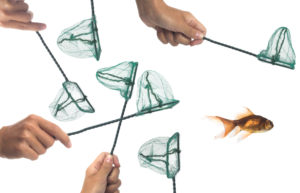“We talked about how to change her behavior. She said she would – and she tried – but she’s back to doing the same thing.”
Sound familiar? Whether you are trying to support another person’s behavior change (or trying to change one of your own – just substitute “I” for “her” in the quote above), our well thought out and intentional plans don’t always create the results we desire.
Expert advice is plentiful. “Say it in different ways.” “Appeal to all of their senses.” “Make sure they understand WIIFM (“What’s in it for Me.”) “Be consistent.” All of that advice is sound, is based on research, and makes intuitive sense. Yet it does not always work. Why?

We think part of the issue is that the person looking to change – and the coach/manager supporting that individual – focuses all of their attention on the behavior itself. What is missing is a concurrent focus on the patterns that underlie that behavior. It’s a variation on the maxim, “If you give a person a fish, they eat for a day. If you teach them to fish, they (hopefully) eat for a lifetime.”
There are two implications of this for coaches. First, consider the bold-faced “teach them to fish” part of the quote. There are several assumptions embedded in that phrase. First – there has to be a sufficient level of awareness of patterns, techniques, and tools that differentiate one way of fishing from another. Second, there has to be language with which to express those differences. Third, there has to be enough connection for sender and receiver to make sense of the exchange. If my fishing guide gives me a book to read in French and I speak (and read) only English, even though the techniques and language are there, the ability to connect is not.
Second, consider the word “hopefully.” There are no guarantees when it comes to changing the behavior of complex systems (like people, teams, and organizations)! These systems behave in “routines” that are functions of history, context, culture and motivation. Each of those “Dimensions” (one of the elements of our Complexity Space™ Framework (CSF)) is continuously changing – sometimes imperceptibly, other times dramatically. Patterns that are effective in one context may not be effective in another. The “how to fish” in warm water on a sunny day is very different than the “how to fish” in cold water on a cloudy day.
Hopefully this perspective offers those of us trying to foster change in ourselves and others some new possibilities:
- Consider the history, context, culture, and motivation that underlies the behaviors in question.
- Pay extraordinary attention to checking for the “connection” between yourself and your coachee. Ask for paraphrases; check for understanding; offer examples and stories as illustrations.
- Be patient. While there are several things you can do to “bump” a pattern (Catalysts in the CSF), there are no guarantee that they will make any difference at all, create change in the direction you hope, or in the timeframe that you desire. Deep-seated patterns took a long time to form – do you really think a couple of conversations will change them forever?
- Be gentle on yourself and the person you’re coaching! The best fishermen sometimes come home with empty creels. Rather than blame yourself or the person you’re trying to help, be curious instead. What worked? What didn’t? What surprised you? What might you try differently next time?
This post is one of several we’ll be creating in the first quarter of 2017 about the applications of the CSF within an organization’s Human Resources and Professional Development strategies. We hope you will share your stories, questions and even disagreements with our articles because that is the only way we can continue to make sure Complexity Works!

Leave A Comment